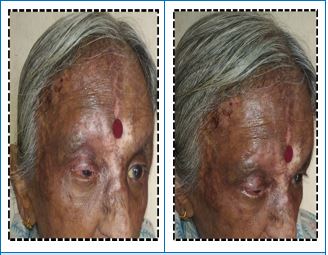Etiology based management of Loota Visha - A Case Report
Keywords:
Loota, Vishagna, Spider, Poison.Abstract
Spiders are the Anthropoids and there are more than 40000 species. In India 600 different spiders are found. Spider bites are common in some parts of the world. In India it is uncommon and fatalities are rare. They are invariably poisonous but majority of species do not pose risk of death. Spider venom is of two types neurotoxic and cytotoxic. Black widow or hour glass spider (cytotoxic) and violin spider or brown recluse (cytotoxic) produces severe toxicity, and act on the myoneural junction or peripheral nerve endings causing ascending motor paralysis or damage to peripheral nerve endings. Death may occur because of infection rather than venom. In Ayurveda Visha mainly classified as Sthavar and Jangam. Sthavar includes plant origin whereas Jangam includes animal origin like snake, spider, scorpion and insects etc. The detailed explanation of Loota Visha origin, symptoms, mode of poisoning and treatment is available in our classical texts. A female patient approached our OPD with complaints of Vesicular lesions on the forehead extending to the right side of temporal region and right eye with oozing since 3 days and she was treated with principles of Agadatantra which includes Vishagna, Kusthagna, Rakshogna etc. The symptoms were reduced completely within short period of time.
Downloads
References
Reddy, K.S.N. (2017) The Essentials of Forensic Medicine and Toxicology. Organic irritant poisons, 34th Edition, Jaypee, New delhi, 526.
Shastri Kaviraj. Sushruta Samhita of Acharya Sushruta (Reprint 2017), Kalpasthana; Chapter 8, Verse 92,93. New Delhi; Chaukhamba Sanskrit Sansthan: 2017; p.95.
Shastri Kaviraj. Sushruta Samhita of Acharya Sushruta (Reprint 2017), Kalpasthana; Chapter 8, Verse 83,84. New Delhi; Chaukhamba Sanskrit Sansthan: 2017; p.94.
Shastri H.; Ashtang Hridaya Samhita of Vagbhat Annotated by Dr. Kunte A. M. and Navre K. (Reprint 2019), Uttaratantra; Chapter 37, Verse 58. New Delhi: Chaukhamba Sanskrut Sansthana: 2019; p.918.
Shastri H.; Ashtang Hridaya Samhita of Vagbhat Annotated by Dr. Kunte A. M. and Navre K. (Reprint 2019), Uttaratantra; Chapter 37, Verse 57. New Delhi: Chaukhamba Sanskrut Sansthana: 2019; p.918.
Shastri H.; Ashtang Hridaya Samhita of Vagbhat Annotated by Dr. Kunte A. M. and Navre K. (Reprint 2019), Uttaratantra; Chapter 37, Verse 55,56,57. New Delhi: Chaukhamba Sanskrut Sansthana: 2019; p.918.
Murthy shrikantha.: Astanga Sangrah Samhita of Vaghabhat Edited by Dr sharma shivaprasad (Reprint 2016) Uttaratantra; Chapter 44, Verse 19. New Delhi: Chaukhamba Sanskrut Sansthana:2016; p.g.883
Shastri H.; Ashtang Hridaya Samhita of Vagbhat Annotated by Dr. Kunte A. M. and Navre K. (Reprint 2019), Uttaratantra; Chapter 37, Verse 48. New Delhi: Chaukhamba Sanskrut Sansthana: 2019; p.917.
Shastri H.; Ashtang Hridaya Samhita of Vagbhat Annotated by Dr. Kunte A. M. and Navre K. (Reprint 2019), Uttaratantra; Chapter 37, Verse 49. New Delhi: Chaukhamba Sanskrut Sansthana: 2019; p.917.
Shastri H.; Ashtang Hridaya Samhita of Vagbhat Annotated by Dr. Kunte A. M. and Navre K. (Reprint 2019), Uttaratantra; Chapter 37, New Delhi: Chaukhamba Sanskrut Sansthana: 2019; p.914-923.
SuryajeetPawar, Ruta, Kadam, SharvariJawale, An open randomized study study of Patolakaturohinyadi kashaya in alcoholic liver disease, International Journal of Ayurveda and Pharma Research, 3(7),(2015).
Kanna S, Hiremath SK, Unger BS. Nephroprotective activity of Bilvādi agada in gentamicin induced ne- phrotoxicity in male Wistar rats. Anc Sci Life. 2015 Jan-Mar;34(3):126-9. doi: 10.4103/0257-7941.157146. PMID: 26120225; PMCID: PMC4458901.
Srikanth, Narayanam & Rana, Rakesh & Jameela, So- phia & Khanduri, Shruti & Amin, Hetal & Anumol, K& Rao, Bcs. (2019). Clinical Evaluation of Efficacy and Safety of Classical Ayurveda Formulations, Panchatikta Ghrita and Nalpamaradi Taila, in the Management of Psoriasis: A Study Protocol. Journal of Re- search in Ayurvedic Sciences. 3. 68-73. 10.5005/jras- 10064-0079.















